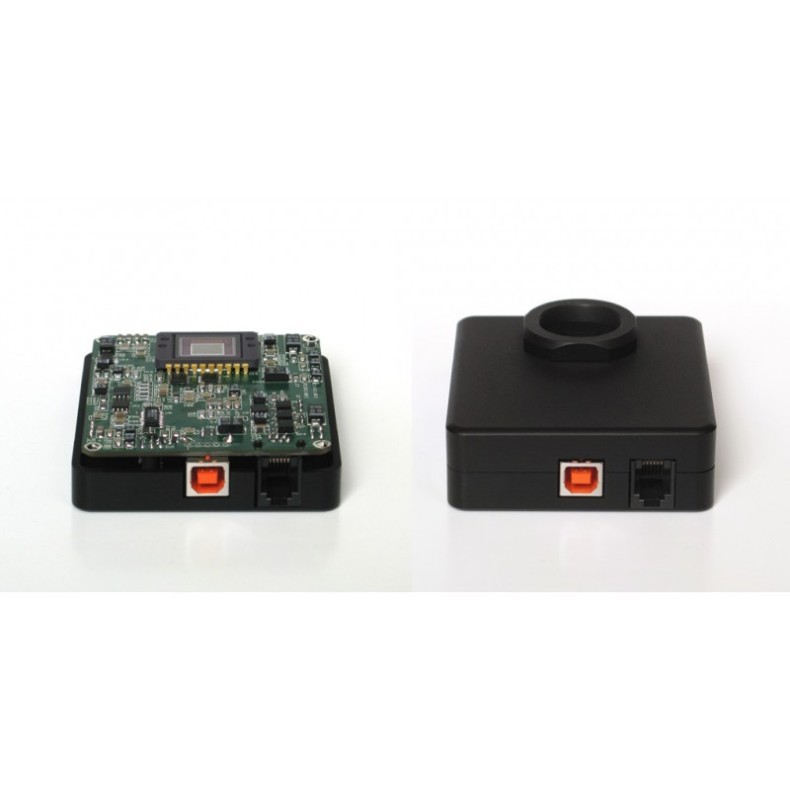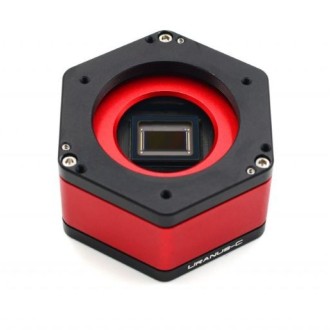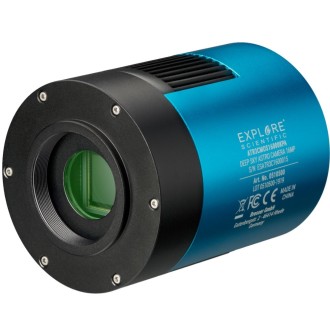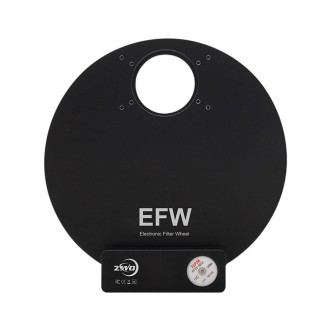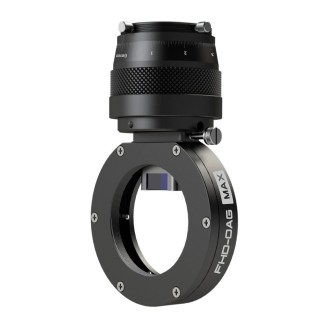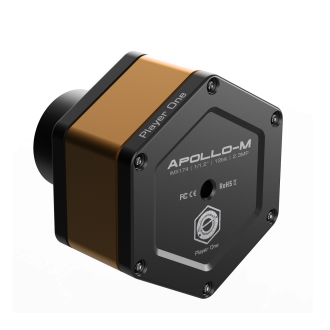Deliver it 18/28 days
MORAVIAN G1-2000C CCD CAMERA WITH SONY ICX274 AQ COLOR CCD SENSOR
The G1 Moravian cameras with the latest CCD technology are the best price/quality choice for astrophotography of the Solar System and bright deep sky objects; they work in low light conditions with very high sensitivity, very low noise, fast image download, electronic shutter and integrated autoguider port for guiding the telescope mount in astrophotography.
| Carrier | Description | Estimated Delivery | ||
|---|---|---|---|---|
 |
Home delivery - International | Home delivery - International |
Wednesday, 12 June - Monday, 24 June |
|

Home delivery - International
Home delivery - International
Estimated delivery:
Wednesday, 12 June - Monday, 24 June
CCD camera Moravian G1-2000C with Sony ICX274 AQ CCD Color Sensor
The G1 series CCD cameras are based on Sony ICX CCD detectors. The cameras are USB powered, so they connect to the PC with a single cable. The standard "Autoguider" port allows the camera to directly control the movement of the telescope. The body of the G1 cameras is slightly larger than the G0 series, as they contain cooling fan, which significantly reduces the CCD dark current. G1 cameras are also equipped with a standard CS thread adapter, making them compatible with various CCTV lenses, microscopes and other devices.
The G1 cameras are very compact, lightweight and easy to operate. The user only needs to insert it into the telescope's eyepiece holder, plug the USB cable into the computer and it works.
Sensitivity is an important feature of any guidance camera. It must provide images of guide star(s) with a sufficient S/R ratio in a fairly short time to ensure perfect guidance. The need to accumulate light for many tens of seconds or even minutes is often unacceptable for high quality guiding. This is why G1 cameras use high sensitivity Sony ICX CCDs with a quantum efficiency of more than 50% and low readout noise.
G1 cameras support 16-bit digitization, significantly improving dynamic range.
Strong blooming protection keeps even the brightest stars round, without saturation spicules.
The G1 cameras also provide very fast readout: the pixel digitization speed reaches 8 MPx/s in fast readout mode.
The G1 series of CCD cameras contains similar electronics to the G0, the same CCD detectors and provides similar functionality. The difference is mainly in the mechanical construction and cooling: the G1 cameras are slightly larger and heavier, but keep the CCD detector at a lower temperature thanks to the built-in fan, which reduces the detector's dark current by more than twice. They also offer a CS thread adapter as well as other adapter alternatives for photographic lenses (Canon EOS and Nikon bayonets, threaded
T, etc.).
The G1 cameras do not require any external power supply, they are powered entirely from the computer via the USB cable. Because the power provided by the USB line is quite limited, these cameras do not use a power-hungry Peltier cooler.
G1 cameras are USB-powered devices (only 1 cable is needed to operate).
The absence of the Peltier cooler does not allow a CCD operating temperature below ambient temperature, but the integrated fan in the G1 cameras keeps the CCD temperature very close.
Although modern astronomical telescope mounts support PC connection, the G1 cameras incorporate a standard 6-pin connector for autoguider input. Therefore, the computer can guide the mount through the camera, even in the case where there is no link between the telescope mount and the PC. (The G1 camera body is equipped with a standard Autoguider connector)
Note: The current of the autoguider port must not exceed 150 mA. If the mount does not treat the autoguider port as "logic input" only, but switches the guiding motors directly by these signals, a "relay box" must be inserted between the camera and the mount. The relay box ensures the switching of the currents required by the mount.
The SIPS (Scientific Image Processing System) control software supports guidance through the camera port as well as through the PC link to the telescope.
The Autoguider port on the G1 camera body follows the standard pinout of the ST-4 guiding cameras, as the G1 series of CCD cameras are designed for guiding as well as CCD imaging, whether astronomical or microscopic. G1 cameras can be used with any C/CS mount compatible telescope or photographic objective.
The SIPS control software treats any CCD camera as an imaging or guiding device. The user chooses which camera will be used for imaging and which one will be used for guiding.
While the monochrome CCD captures all incoming wavelengths (to which the detector is sensitive), the color CCD detector has red, green and blue filters applied to individual pixels, arranged in a so-called Bayer mask. The monochrome CCD is substantially more sensitive, but multiple exposures through color filters are necessary if color images are to be captured. On the other hand, the color detector limits the incoming light through the color filters, but allows reconstruction of the color image from a single exposure, even if the color resolution is lower than the CCD pixel array.
Although so-called full-frame (FF) CCDs achieve the highest sensitivity, they can only be used in conjunction with a mechanical shutter; in contrast, so-called interlinear transfer (IT) CCDs are equipped with an electronic shutter, which allows very short exposures. This is why G1 cameras use IT detectors. Furthermore, IT sensors differ in terms of image readout: while progressive readout chips can read all pixels of the image at once, interleaved readout CCDs divide the frame into two half-frames containing only odd or even rows and read the text independently.
G1 guidance cameras are designed to work in cooperation with a computer (PC). The guidance algorithms are performed by the PC, not by the camera itself. To operate the camera, a PC with a 32-bit or 64-bit Windows operating system with at least one free USB port is required.
Note: Linux drivers are also available. Contact us if you are interested in Linux drivers.
Technical specifications
CCD chip
G1 cameras use sensitive, low-noise Sony ICX CCD detectors with estimated quantum efficiency (QE) exceeding 50%. The dark current and read noise of these CCDs are very low. The G1-2000 model uses Sony's ICX274AQ UXGA (1600 × 1200 pixels) chip with progressive readout and RGBG Bayer mask for color reproduction.
- Resolution: 1628 (H) × 1236 (V) pixels
- Pixel size: 4.4 μm (H) × 4.4 μm (V)
- Image area: 7.2 mm (H) × 5.4 mm (V)
- Discharge time: ~ 0.25 s
Camera electronics
The 16-bit A/D converter with correlated double sampling guarantees a high dynamic range, which in fact exceeds the electron well capacity of each CCD pixel. The fast USB interface guarantees image download time in fractions of a second.
The maximum length of the USB cable is 5m. This length can be extended, for example, to 10 m using a USB hub or USB extender cable. An extension of up to 100 m can be achieved with extenders.
- Resolution: ADC 16 bits
- Sampling method: Double correlated sampling.
- Reading modes: fast (8 Mpx / s) // slow, with very low electronic noise (2.5 Mpx / s)
- Sub-frame reading: Yes
- Computer interface: Hi-Speed USB 2.0, compatible with USB 1.1 Full Speed
Note: The SIPS control software allows resizing by changing the binning via software if lower resolution images are desired.
Chip cooling
The G1 series CCD cameras do not use active cooling with Peltier TEC modules, so the CCD cannot be cooled below ambient temperature.
When working the electronic circuits (including the CCD chip) produce quite a lot of heat, so they raise the internal temperature of the camera quite a few degrees above the ambient temperature. Because the thermal noise of the CCD generally doubles every 5 to 7°C, the thermal noise can be two or more times higher after some time of camera operation. The G1 series of CCD cameras contains a small fan, which efficiently removes heat from the camera body and keeps the CCD temperature as close as possible to the ambient temperature. The fan can be controlled from the software.
G1 cameras also include the built-in temperature sensor, which measures the current temperature of the CCD. This feature allows you to monitor the temperature of the CCD and ensure that the dark frame used was taken at the same or similar temperature to scientific shots that have had light exposure.
Power supply
The G1 cameras are powered from the USB cable. No external power supply is required.
The current limit for a single USB device is 500 mA at 5 V power supply. The current required by the G1 cameras varies depending on the camera's operating mode. The following table summarizes the camera consumption without reaching, in any case, the 500 mA limit, defined in the USB specification.
- Idle mode, with fan off 185 mA
- Idle mode, with fan on 260 mA
- Image digitizing mode, with fan off 285 mA.
- Image digitizing mode, with fan on 360 mA.
Note: Some USB cables incorporate very fine electrical lines with relatively high resistance. If the USB device draws several hundred milliamps, the voltage drop on that cable may be around one volt. Although the G1 camera should work, some features may be adversely affected. Always make sure that the USB cable used is as short as possible and with low resistance electrical lines.
Mechanical specifications
The compact and robust camera body measures only 83 × 76 × 26 mm. The body is CNC machined from high quality aluminum and anodized black.
The body is equipped with CS or C threads for attaching various CS or C photographic lenses. The C to 1.25" thread adapter can be screwed onto the body to connect the camera to any telescopic focuser that accepts standard 1.25" eyepieces.
G1 cameras use interline transfer CCDs and do not contain a mechanical shutter. It is necessary to manually cover the telescope to take a dark or bias (offset) frame.
- Internal mechanical seal: No
- Shortest exposure time: 0.125 s
- Longer exposure time: limited only by chip saturation
- Body dimensions: 83 mm × 76 mm × 26 mm
- Rear focal length: 12.5 mm (standard CS thread) / 17.5 mm (standard C thread)
- Camera body weight: 0.2 kg
Note: The camera dimensions do not include the CS thread adapter. The depth of this adapter is 6.4 mm, so the depth of the camera including the CS thread adapter is 32.4 mm.
Guided
Although the G1 series CCD cameras are capable of imaging various objects in astronomy, microscopy or other low-light imaging applications, they are primarily intended for guiding telescope mounts using G2, G3 or G4 cameras as the main camera for scientific purposes.
The G1 camera can function as a "remote guide body" for any CCD camera, including the Gx series. The fact that it is not connected to the Gx camera body by some proprietary cable, but directly to the USB port of the PC, brings numerous advantages:
- The guiding camera can guide any astronomical camera or digital SLR camera, not just the type of main camera for which it is designed.
- There are no proprietary connectors/cables to connect the main camera to the remote body. Instead, a standard USB cable is used.
- There is virtually no limit to the distance between the guiding camera and the scientific imaging camera, so the guiding camera can be placed on any guiding telescope or on an off-axis guide.
- Even if the guiding camera shares the same telescope with the main camera-using an off-axis guide-the light feeding the guiding camera is deflected before it passes through the filters, so there is enough light to guide even when the main imaging camera takes the exposure through some very "dark" filters, such as UV, Blue, or Hα.
- Moreover, the USB hub is able to create an integrated solution for two Gx and G1 cameras that previously operated separately.
SIPS guidance software:
The G1 guidance camera connects directly to the PC's USB port or USB hub, without requiring a "CPU box" or similar device. The guidance algorithms are performed on the PC itself, and since the CPU used by a PC is several orders of magnitude more powerful than any integrated CPU that can be used in any CCD camera, the guidance algorithms can be much more sophisticated. Such algorithms are implemented in the SIPS camera control software.
There are two algorithms used in SIPS for guidance:
- Single star guidance. The PC calculates the centroid of the brightest star in the image acquired by the guide camera. The centroid position is calculated with an accuracy of fractions of a pixel, so the guide can be very accurate even when the guide is attached to a short focal length telescope.
- Astrometric reduction guidance. The PC performs basically the same operation as in the case of multiple-exposure sub-pixel matching or astrometric reduction. The number of triangles are created from the brightest stars and matched with triangles in the reference frame. Triangle matching requires at least three stars in the guide image and is therefore suitable for either short focal telescope-guides or rich star fields; the image offset is calculated from multiple star positions and is less sensitive to random errors arising from poor seeing, blooming spicules, etc.
The SIPS guiding support allows the incorporation of the Autoguider port of the G1 camera, which is de facto standard and compatible with various telescope mounts. SIPS can also guide via the telescope link itself (e.g., via the Meade LX-200 or Celestron Nexstar), so an autoguider cable may not be necessary, but a specialized guiding device such as the G1 camera guide can generally control the mount with much better accuracy compared to the relatively limited time resolution of an application running on the PC.
CCD camera Moravian G1-2000C with Sony ICX274 AQ CCD Color Sensor

